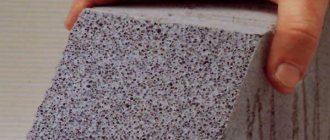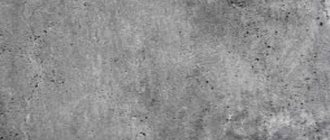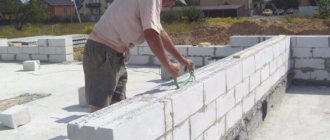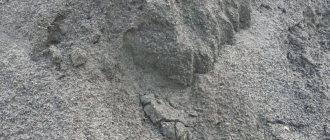The main types of concrete intended for the construction of residential and commercial buildings are light and heavy concrete. Light and heavy concrete are based on four components: cement, large and small aggregates for concrete and a mixer (water).
Large aggregates determine the strength of concrete, and small aggregates perform an auxiliary function - ensuring reliable contact between particles of large aggregate and the binder. To make light and heavy building materials, different types of coarse and different types of fine filler are used.
Impact of aggregates on quality
The quality of aggregates greatly influences the quality of reinforced concrete.
The quality of aggregates is assessed by the following indicators:
physical and mechanical properties:
- strength,
- frost resistance,
- impact resistance,
- abrasion,
- density,
- emptiness,
- water absorption,
- volumetric weight in a piece,
- bulk;
geometric characteristics:
- grain composition,
- size,
- form,
- degree of roundness,
- grain roughness;
- degree of purity and required good quality; content in aggregates of harmful and contaminated impurities, weak and unstable inclusions, petrographic homogeneity.
Fine aggregate
It is sand - a product of natural destruction or crushing of rocks that meets the requirements of GOST.
The most important qualitative characteristic of sand is its grain (granulometric) composition, which affects all the properties of concrete, especially high-strength concrete. The grain composition of sand especially strongly influences the technological properties of the concrete mixture - its mobility, rigidity, workability and formability, which are reflected in the consumption of water and cement in concrete, the compaction coefficient of the mixture with the available equipment. An optimal combination of specific surface area and sand size is required.
Sand (with a grain size from 0.14 to 5 mm) is introduced in the smallest quantity, at which the mortar part of the concrete mixture receives the viscosity necessary to maintain crushed stone or gravel in suspension during transportation and laying. To obtain the same viscosity of the solution, different amounts of sand can be added to the same amount of a given cement glue, depending on its properties; The glue and excess water in it are placed on the surface of the grains. Therefore, the value of the latter per unit volume of sand (specific surface) and the size of its grains are of significant importance - with fine sand, more cement glue is required.
To reduce the amount of glue in concrete, it is also necessary to take into account the voidness of the sand, i.e., the volume of its intergranular space, expressed as a percentage (of the volume of sand); the lower it is, the less cement adhesive is required in concrete.
Characteristics of the grain composition of sand are its fineness modulus (Table 1) and sieving curves (Fig. 1).
| Sand group | Total residue on sieve No. 063 by weight, % | Size modulus*, Mk | Specific surface area, cm2/g | Passes through sieve No. 014 but weighs. % |
| Large | More than 50 | More than 2.5 | — | To 10 |
| Average | From 35 to 50 | 2,5—2,0 | — | To 10 |
| Small | — | Less than 2.0 | 100-200 | Up to 15 |
| Very small | — | — | 201—300 | Up to 20 |
* The quotient of the sum of total residues on all sieves with openings of 2.5 to 0.14 mm divided by 100.
Usually, dust-like and clayey impurities contained in sand with a highly developed specific surface area and sometimes significant water absorption (swelling) sharply increase the viscosity of the solution and do not allow the introduction of a significant amount of sand into it. Therefore, the content of such impurities in sand for concrete of prefabricated structures of grade 200 and above is allowed no more than 3% by weight, including clay no more than 0.5%. In addition, the sand should not contain organic acids, the neutralization (saponification) of which requires free lime released during the hydrolysis of C3S cement.
Fine sand, previously dispersed into fractions, can be enriched by adding other sands with larger grains. These include sands that are natural or obtained by crushing stone into crushed stone from unweathered igneous, metamorphic or sedimentary rocks (limestones) with a compressive strength (in a water-saturated state) of at least 400 kg/cm2.
Types of Additives
Additives are divided into several groups:
- additives to change physical properties such as plasticity, mobility, elasticity, pore formation;
- additives for accelerating or retarding setting, increasing the shelf life of the concrete mixture;
- pigment and coloring additives to impart decorative properties;
- means for expanding the mixture, reducing shrinkage and cracking;
- water repellents and waterproofing compounds.
Coarse aggregate
Crushed stone is obtained by crushing rocks, preferably igneous ones.
The share of coarse aggregate in the average cost of 1 m3 of prefabricated structures is very large - it reaches 15%, which is equal to the cost of cement in concrete. Therefore, compliance with the necessary requirements for the quality and properties of crushed stone and gravel for these structures is of great importance and must be differentiated for different concretes. In addition, it is advisable to have an optimal combination of individual fractions of coarse aggregate.
For concrete, it is recommended to use aggregate consisting of several fractions. The mixture of fractions of coarse aggregate should ensure that it is obtained with less voidage and, therefore, with the highest volumetric weight.
Of the physical and mechanical properties of crushed stone or gravel with particle sizes from 5 to 70 mm, in addition to the combination of individual fractions, the most important are strength and, in some cases, frost resistance; The strength can be directly determined only for crushed stone by testing the compression of cubes or cylinders (50 mm in diameter and height) made from the rocks in which it is obtained by crushing.
According to GOST “Aggregates for Heavy Concrete”, the grade of aggregate in a water-saturated state should be: higher than the grade of concrete: 1.5 times if its grade is below 300 kg/cm2 and no less than 2 times if the grade of concrete is 300 kg/cm2 and higher.
If direct testing of the original rock is not possible, the suitability of gravel or crushed stone for concrete is determined by testing a sample of them for crushability under a static load in a steel cylinder with a diameter and height of 150 mm.
Classification by purpose
There are placeholders for specific uses:
- obtaining heavy or lightweight building materials;
- preparation of decorative mixtures;
- creating dense concrete with increased thermal insulation;
- formation of acid-resistant, heat-resistant, radiation-resistant or similar products for special purposes.
Return to contents
Special fillers
Heat resistance, fire resistance, radiation resistance, increased porosity, frost and heat resistance and similar properties are endowed with products with a solution of specific filling substances.
Return to contents
Porous
Volcanic slag.
There are three main types:
- Natural - pumice, volcanic slag or tuff, carbonates.
- Artificial - expanded clay, agloporite, granulated or dump slag, expanded perlite or vermiculite.
- Obtained from industrial waste - fuel, waste or metallurgical slag, coarse fly ash and ash and slag mixtures.
Their size should fluctuate in the average range of 5-40 mm.
Return to contents
Thermal insulation
For warm screeds, heat-insulating ultra-light fillers are used: artificial polystyrene or sawdust of natural origin.
Return to contents
Tests
The admissibility of this method is explained by the fact that when compressed by Poisson, pieces of filler, resting on each other at separate points, work in tension under the influence of splitting forces, i.e., to separate one part of the piece from another, and the less tensile they are, the greater the value their fragmentability will be greater. In addition, by determining the average strength of a large number of grains in a sample of crushed stone or gravel instead of the average strength of individual samples of their original rock (from the strength of which, as is known, the strength of grains of different fractions of crushed stone differs significantly), we obtain a more correct assessment of the strength of coarse aggregate.
If the coarse aggregate does not meet the above requirements, the question of its suitability for concrete of a given grade is decided by testing in concrete, which can be done in the following way, developed by I. M. Frenkel and A. S. Dmitriev. According to the required grade of concrete and the available cement, the amount of glue, determining W/C. Then two series of concrete samples with glue of the required quality are prepared: one with a coarse aggregate content in the concrete of about 750 l/m3 and the other with at least 850 l/m3. The cement consumption is normal for the consistency of the mixture from which the samples are prepared.
After 28 days of standard storage, both samples are tested for compression. If their strength is not lower than the brand, the tested aggregate can be used for concrete of this brand. If the required strength is achieved only in samples where there is less aggregate to be tested, it can be used at a rate of no more than 750 l/m3 in concrete. In the same case, when the strength of concrete of both series is lower than the required grade, the filler is considered unsuitable. If necessary, the specified testing of samples using forced hardening of concrete (steaming) can be carried out earlier than 28 days.
In addition, it is unacceptable to use weathered rocks, igneous and sedimentary rocks for concrete, as well as those whose silica can react with cement alkalis if it contains more than 0.6% Na20 + K20 (andesites of afinite and porphyry structure, siliceous and opal-containing -shales, chalcedony limestones and conglomerates, rhyolite tuffs, etc.).
In gravel and crushed stone, the content of sand should be limited and the presence of clay should be excluded, since their large specific surface area causes an unacceptable increase in the content of cement glue in the concrete mixture.
Coarse aggregate must be multi-fraction, since in single-fraction, large intergranular voids lead to an increase in the glue content in the concrete mixture.
For rigid concrete mixtures, single-fraction aggregate can also be used using a fine fraction for thin-walled products. To assess the grain composition of the filler, its sifting curve is compared with the curves of the material with the limit curves of the quality filler. When the sieving curve goes beyond these limits, a fractionally corrected aggregate composition is used.
In addition to the above, the filler must meet the requirements of frost resistance, which is determined by the number (15 or more) of cycles of alternate freezing and thawing of the filler or accelerated testing in a sodium sulfate solution.
Particularly stringent requirements must be met in the manufacture of thin-walled and high-strength prestressed structures.
General information
What is a placeholder? As a rule, this is a small crushed stone, the choice of which most often depends on the nearest deposits.
Traditional fillers for concrete are the following components:
- Crushed stone;
- Sand;
- Gravel;
- Pumice, and much more.
Often all kinds of waste, such as slag, are used as fillers. Their use is due to savings, since the price of concrete in this case is significantly reduced.
As a rule, aggregates dissolved in concrete account for 80-85% of the total mass. It follows that the importance of choosing this component is difficult to overestimate, since it makes up the main part of the material.
Percentage of components in concrete
Aggregates for ordinary concrete
Fillers for ordinary concrete are divided into:
- by grain size: large (gravel and crushed stone with grains 5-150 mm in size) and small (sand with grains 0.15-5 mm in size);
- according to the grade of coarse aggregate: ordinary (grain size 5-150 mm) and varietal (grain size 5-20, 20-40, 40-80, 80-150 mm).
The maximum size of gravel or crushed stone for beams and columns should be no more than 1/3-1/4 of the smallest section size and no more than the clear distance between the reinforcement bars.
The size of the aggregate and its grain composition are determined in the laboratory by sifting through a standard set of sieves.
For this, a set of sieves is used, the hole sizes of which are in mm: square holes - 0.14; 0.3; 0.6; 1.25; round holes - 2.5; 5; 10; 40; 80.
After weighing the residues on each sieve, the partial and total residues are determined as percentages. The total residue for a given sieve is understood as the sum of the partial residues on all larger sieves plus the partial residue on this sieve.
The sand fineness modulus is the fractional separation per 100 of the sum of total residues on all sieves, starting from a sieve with a hole size of 8.5 mm and ending with a sieve with a hole size of 0.14 mm. It must be borne in mind that sifting (determining partial and total residues), and then determining the sand size modulus based on the results of sifting, is carried out on a sand sample after fractions larger than 5 mm have been removed from it.
Sands are divided into groups according to their size. The use of fine sands for construction work is allowed only if there are technical and economic grounds in each necessary case confirming the feasibility of their use. The amount of dust and clay (silt) particles in the sand, determined by elutriation, should not exceed (in % by weight)
- for concrete - 5;
- masonry mortars - 10;
- plaster solutions—15.
| Sand group name | Fragility modulus | Total residue in % on sieve with mesh No. 063 |
| Large | 3,5-2,4 | from 50 to 75 |
| Average | 2,5-1,9 | from 35 to 50 |
| Small | 2-1,1 | from 20 to 35 |
| Very small | 1,6-1,1 | from 7 to 20 |
| Thin | less than 1.2 | less than 7 |
The content of grains in the sand passing through sieve No. 014 should not exceed (in%) the sand used
- for concrete - 10;
- in sand for masonry and plaster mortars - 20.
The largest grain size (in mm) in sand for masonry and plaster mortars should not exceed:
- made of bricks and stones of regular shape - 2.5;
- from rubble stones - 5;
- in plaster mortars used for the plaster layer: preparatory - 45;
- finishing—1,2.
The above classification of sands and requirements for the content of fine fractions in them
The use of fine sands for concrete leads, as a rule, to increased consumption of cement with the existing technology for the production of concrete work.
All other things being equal, the mobility of concrete mixtures is greater, the smaller the specific surface of sand grains (measured by the total surface of grains per unit weight in cm2/g). Therefore, replacing clean coarse sand with clean fine sand worsens the workability of the concrete mixture and requires greater cement consumption. For concretes of equal strength, prepared from concrete mixtures of the same mobility, the use of fine sand leads to an increase in cement consumption from 8 to 25%.
When using fine sand, the relative excess consumption of cement per 1 m3 of concrete depends on many factors and, in particular, on the contamination of sand with clay and silt particles. Replacing coarse sands with fine ones in concrete causes an increase in cement consumption, the more, the more grains in the sand with a particle size below 0.14 mm.
If fine sand is clean, then comparing it with coarse sand, but containing more silt and clay particles, may give the opposite result. Cement consumption per 1 m3 of concrete may be less when using fine, clean sand compared to using coarse, contaminated sand. Thus, the purity of the sand is the most important factor in determining the feasibility of using a particular sand for concrete.
It was noted above that the provision for increased cement consumption when using fine sands occurs, as a rule, with the existing technology for the production of concrete work. As concrete technology improves and new efficient machines appear for the preparation of concrete mixtures and for their intensive compaction when laying or molding products, it will be possible to use fine sands in concrete without excessive consumption of cement.
In addition to grain size, another important characteristic of aggregates is void volume. In sand the volume of voids should be no more than 40%, in gravel 45% and in crushed stone 50%. The volume of voids in sand or gravel can be easily determined by filling a measuring cup with aggregate with water: the volume of voids is equal to the volume of water poured in.
The content of clay and dust impurities in the sand is determined by elutriation in a glass cylindrical vessel with water. As a result of elutriation, sand is deposited at the bottom, and dust and clay form a clearly visible layer on top. After measuring the thickness of the layer of impurities and settled sand, the percentage of clay particles is calculated.
To improve the properties of aggregates, they are processed (enriched). The grain composition of sand can be improved by mixing fine sand with screenings from crushing crushed stone. To improve the grain composition of crushed stone, you can add grains of different fractions, for example, fine gravel.
Mortars used for plastering work, as well as for masonry, must contain sand consisting of grains corresponding in size to the thickness of the seam. If the sand contains larger grains than allowed by technical specifications, satisfactory results are obtained by sifting the sand through a mesh with holes 1-5 mm in size, depending on the purpose of the solution. A sand seeder is used for this.
For critical structures, it is recommended to disperse crushed stone into two grades: 5-20 mm and 20-40 mm. The mixing proportion of these varieties is determined when selecting the concrete composition based on the condition of obtaining a mixture with the highest volumetric weight. A good mixture is obtained by mixing large and small grains.
When using crushed limestone as a coarse aggregate, it should be taken into account that the strength of limestone varies greatly. It is also necessary to pre-test limestone stone for strength and water absorption.
Crushed brick used for the production of low-grade concrete must be uniformly red in color with a dense structure. Metallurgical slags, previously subjected to laboratory testing, can be used as coarse aggregate, without which their use is unacceptable.
Aggregates are taken by volume and measured in stacks or in vehicles.
When receiving sand, and then during further operations with it (volumetric dosages, etc.), it is necessary to take into account that the volumetric weight of sand fluctuates within significant limits depending on humidity.
Sand occupies the largest volume and has the lowest volumetric weight at 5-7% humidity. If we take the volume of a certain amount of dry sand as 100, then its volume at different humidity levels will correspond to the data in Table.
| Sand moisture content in % | 0 | 5 | 10 | 15 | 20 | 25 | 30 |
| Sand volume in % | 100 | 135 | 130 | 115 | 100 | 95 | 90 |
Some features of using different brands of solution
M100-250 are considered publicly available and popular brands of this building material. Such compositions are used as a universal material, used as an auxiliary solution in the process of preparing for pouring work to create monolithic structures, as well as for laying reinforcing bars, etc. Such commonly available brands have low strength characteristics and a complete absence of specialized additives.
For construction work during the construction of residential buildings, it would be most appropriate to use mixtures of grades M 300-400.
They demonstrate excellent practical characteristics and properties, and their price is quite affordable for the modern consumer.
The brand of concrete called heavy, M500, is quite difficult to find on sale. This material is quite capricious, but at the same time as durable as possible. Only professionals with extensive experience in construction can work with it. The use of this mark is necessary only when constructing objects of special purpose or public importance.










